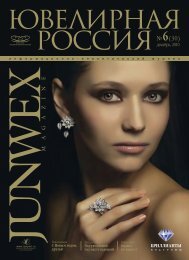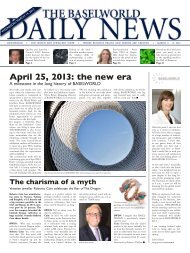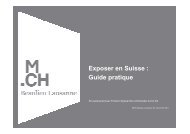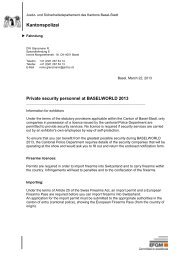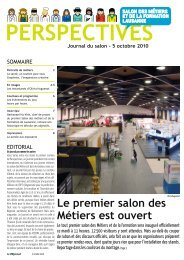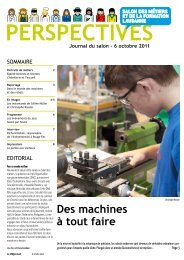WatchTime - August 2012
WatchTime - August 2012
WatchTime - August 2012
You also want an ePaper? Increase the reach of your titles
YUMPU automatically turns print PDFs into web optimized ePapers that Google loves.
CLOSE-UP<br />
Patek Philippe Reference 5204<br />
A COMPARISON OF THE<br />
TWO ISOLATORS:<br />
Conventional isolator in caliber<br />
CH 27-70/150 (“octopus”)<br />
A conventional split-seconds isolator needs two<br />
oppositely acting springs. One of them is affixed<br />
below the split-seconds wheel; the other is<br />
attached above it. These two springs alternately<br />
control the connection between the split-seconds<br />
wheel and the chronograph’s center wheel. This<br />
elaborate construction burdens the split-seconds<br />
wheel with additional moved mass, which in turn<br />
affects the balance’s amplitude. Furthermore, the<br />
bearing for the chronograph’s axle is also additionally<br />
stressed and the height of the movement<br />
must be increased.<br />
Isolator in the new caliber<br />
CHR 29-535 PS Q<br />
In Patek Philippe’s new construction, only one<br />
spring, above the split-seconds column wheel and<br />
working in two directions, is needed. The new<br />
split-seconds mechanism is simpler to construct.<br />
Its principal advantage is that the weight of the<br />
springs is shifted from the split-seconds, which<br />
must be moved, to the static column wheel and<br />
the plate. This construction takes much of the<br />
load off the bearing for the chronograph’s axle<br />
and makes the movement thinner than it would<br />
be with a conventional isolator.<br />
58 <strong>WatchTime</strong> <strong>August</strong> <strong>2012</strong><br />
The so-called “octopus” isolator<br />
in caliber CHR 27-70/150<br />
satisfy Patek Philippe’s needs until the 1980s. When the ébauches<br />
ran out, Patek Philippe chose as its new supplier the<br />
renowned Nouvelle Lémania ébauche manufacturer. The agreement<br />
between Patek and Lémania regulated delivery of all basic<br />
components for caliber 2320, including the plate. Everything<br />
else was handled by Patek Philippe on its own premises in Geneva.<br />
Patek Philippe modified more than 60 percent of the components<br />
delivered by Lemania. Reference 3970, which had a<br />
chronograph and perpetual calendar, debuted at the Basel fair in<br />
1986. Connoisseurs had to wait 10 years for the split-seconds<br />
version, Reference 5004.<br />
That watch was powered by Caliber CHR 27-70/150, 8.86<br />
mm tall and containing 404 components. The split-seconds<br />
mechanism, which was developed by the manufacture, included<br />
an unconventional component with a shape that strongly resembled<br />
the tentacles of an octopus. This so-called “octopus<br />
wheel” performed an important and innovative function. In ordinary<br />
mechanisms, the little ruby roller of the split-seconds<br />
lever continues to run around the split-seconds heart when the<br />
split-seconds hand is stopped. This saps energy and therefore reduces<br />
the balance’s amplitude. Patek Philippe counteracted this<br />
not inconsiderable loss of energy by equipping caliber CHR 27-<br />
70/150 with an isolator. This component completely uncouples<br />
the split-seconds wheel from the chronograph’s center wheel<br />
A Patek Philippe split-seconds chrono from the<br />
1920s with movement by Victorin Piguet



